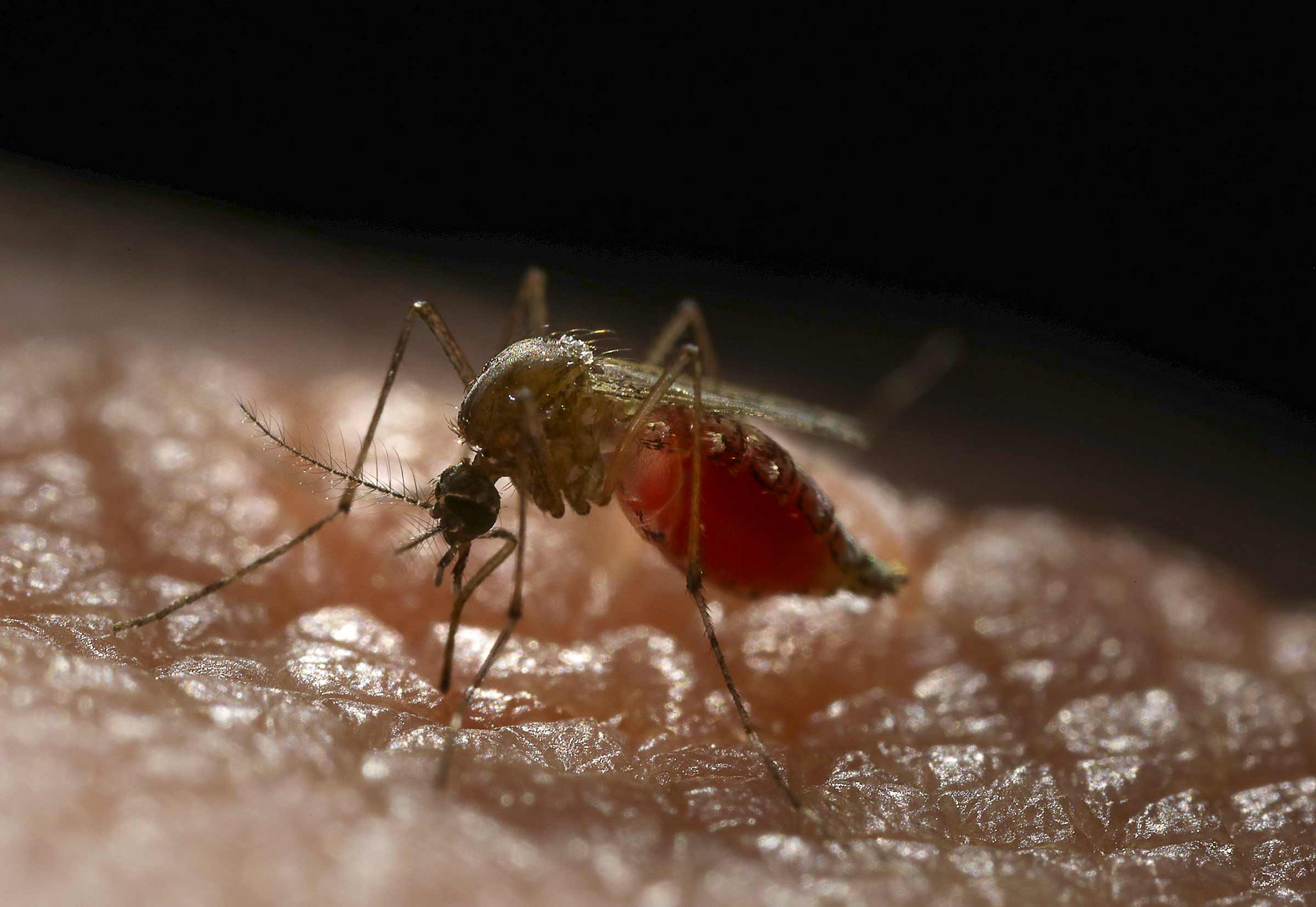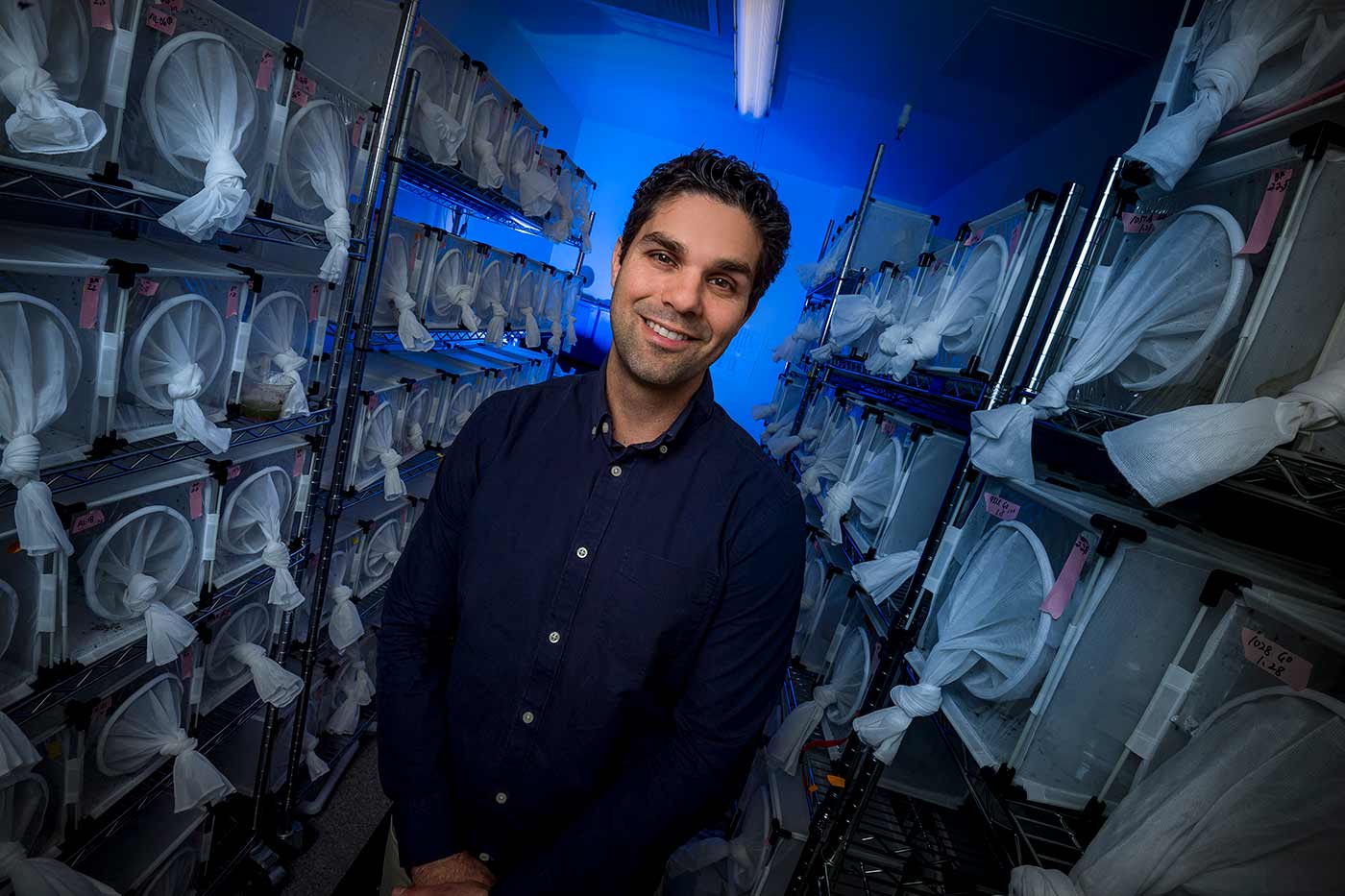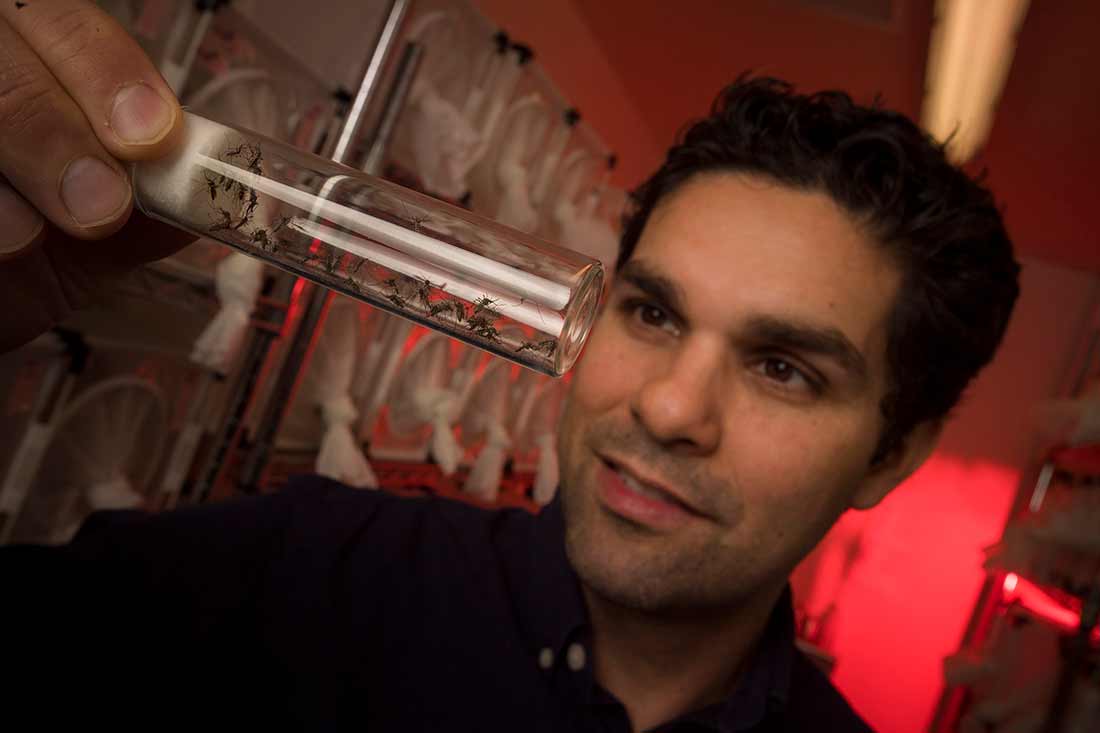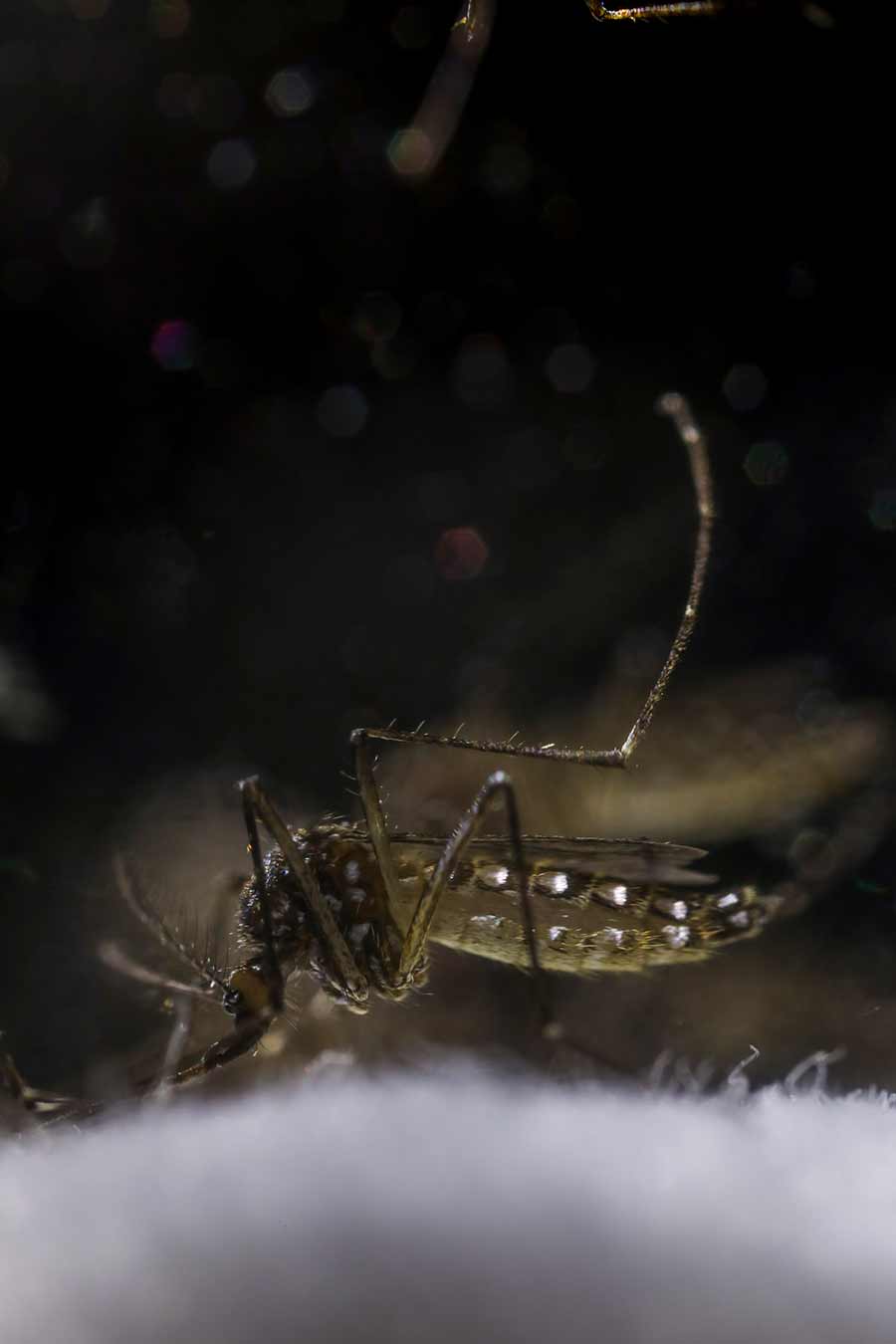
By:
- Mario C. Aguilera
Published Date
By:
- Mario C. Aguilera
Share This:
Taking Aim at Mosquitoes and Disease
With trailblazing genetic technologies and a passion for a certain blood-sucking bug, a new UC San Diego biologist joins the campus' campaign against disease transmission

Photos by Erik Jepsen/UC San Diego Publications
Enter Omar Akbari’s insect zoo and it’s immediately clear that you’ve entered a different world. It’s not that you’ve passed through several layers of containment that keep the bugs securely locked away… nor the fact that the temperature has just escalated 20 degrees… nor that the room is kept at 60 percent humidity—just the way mosquitoes like it.
Rather, what becomes immediately apparent is Akbari’s unmistakable affinity for the pests and an ability of knowing just about everything there is to know about them.
Having just arrived on the UC San Diego campus as a faculty member in the Division of Biological Sciences, Akbari comes armed with a unique skill set aimed squarely at disease-carrying insects and the potential to revolutionize how we fight them. Just as canine experts can unmistakably identify this Lhasa Apso and that Shih Tzu, and how to breed each, Akbari’s mosquito expertise affords him uncanny perspectives on how to stop mosquitoes from spreading disease.

New UC San Diego molecular biologist Omar Akbari stands in his laboratory among hundreds of mosquito cages.
With a quick glance inside one of the stacked cages in his lab, Akbari deftly identifies a mosquito’s species… its sex… mating habits…. feeding regimen… and what a mosquito is doing at any given moment. To the casual observer, it might appear as a bunch of bugs sitting idly around a cage. But through Akbari’s lens, this scenario is much more. Years of getting to know these blood-lusting creatures tells Akbari that these males are passionately waiting for the opportune moment a female is ready to mate, a situation accelerated when Akbari kick starts the mating ritual with a quick blast of air to get things stirred up.
He can carefully describe the process through which a mosquito pierces human skin and extracts blood, and with it the potential of transmitting pathogens. And he explains all of this while a hungry mosquito is feeding off of his blood.
For the love of mosquitos
Omar Akbari’s story doesn’t trace the typical narrative of an emerging biologist. No early attraction to science. No stories of youthful adventures as a backyard wilderness explorer. Shockingly, not even a bug-collecting kit.
His story starts in the placid town of Idaho Springs, Colorado. Set in the mountains an hour’s drive from Denver, Akbari grew up the proud son of the owner of the town’s only movie theater. His passion for science began to blossom in high school but didn’t shift gears until he attended the University of Nevada, Reno, where he took a job in a lab that exposed him to the wonders of science.

An insect geneticist with field and laboratory training, Omar Akbari specializes in devising ways to genetically halt the spread of disease-causing pathogens.
“I started reading scientific papers and quickly began to love science,” said Akbari, who speaks in deceptively hushed tones but gradually ensnares his audience with the confidence that they are listening to someone who has clearly found his passion and purpose in life. “The ability to explore questions was really interesting to me. The idea that you could actually solve real-world problems became what I’m most interested in—the ability to save lives.”
During his four summers in Reno earning combined bachelor’s and master’s degrees, he found a job that taught him all there is to know about eradicating pathogen-carrying bugs, known as “vector control.” He recalls the thrill of going into the field and bringing back mosquitoes to test for West Nile virus and other pathogens.
“I learned how mosquitoes are controlled but I also learned about the cost and environmental impact, which was shocking and ridiculous,” said Akbari, who also obtained his Ph.D. at the University of Nevada, Reno. “Having first-hand exposure to vector control and seeing the chemicals, oils and insecticides that were in use—I found that to be a major problem. I feel like that motivated me to try and invent a solution.”
During his next stop at a postdoctoral position at the prestigious California Institute of Technology, Akbari’s relationship with mosquitoes deepened. His seven-year stay in Caltech Professor Bruce Hay’s lab provided an unusual level of expertise, along with a lasting bond with the insects.
“Omar is one of the most talented, hardworking and imaginative young people I have seen,” said Hay. “He and UC San Diego are going to do great things together.”
“I was at work all the time and basically lived with the mosquitoes,” he said. “I learned how to rear them. But I also learned from them. If you look at the number of mosquitoes we have in our lab today, you’ll see that we’ve optimized the process of raising them for research. No other lab has this many different strains. (My lab) has become really good at it, and it’s because I lived with them and worked with them so closely.”
Know thy enemy
Globally, more than three billion people are at risk of infection from malaria, which causes some 450,000 deaths per year and takes a child’s life every two minutes. For Akbari, these statistics are of interest personally as well as professionally. With two kids of his own at home, he openly wonders about how he would feel if one of his own was bitten by a mosquito and became infected.
Even with a clear affinity for mosquitoes, Akbari is quick to point out that they are perhaps the most dangerous animals in the world. His specialty is the species Aedes aegypti, also known as the “yellow fever mosquito,” which can also spread Zika, dengue and chikungunya—diseases with no effective vaccines.

The yellow fever mosquito, Aedes aegypti, transmits the Zika virus and dengue fever.
Akbari and the nine members of his lab are on a mission to invent genetics tools and technologies that control the spread of disease and prevent pathogen transmission. They look to devise ways of driving laboratory-engineered genes—which disrupt normal pathogen inheritance pathways—into wild mosquito populations. Of late, Akbari is excited about prospects of a new weapon. He’s attempting to create genetically sterile mosquito males, which mate with wild females and pass the genes to their offspring. The eggs hatch and die as larvae.
“You are releasing males that mate and produce no viable offspring,” said Akbari. “Over time that suppresses specific populations. This has been shown to significantly reduce specific insect populations.”
The concept has been proven in fruit flies and Akbari is giddy at the prospects of trying the method in mosquitoes that carry pathogens.
“(Akbari) is always full of so many ideas and I think many of us in his lab are amazed at how he comes up with them,” said Anna Buchman, a researcher who has known Akbari for more than 10 years and worked in his lab for the past three. “For example, we are working on Zika-resistant mosquitoes. Omar just gets ideas and says, ‘Let’s just try this.’ A lot of those types of projects actually start to become big things but started in a minor direction.”
With such non-traditional approaches to solving mosquito disease transmission, Akbari will be working alongside researchers in the campus’ new Tata Institute for Genetics and Society in using UC San Diego-developed genetics technologies to eradicate malaria in India, as well as agricultural and health-related applications. As with the entire Tata Institute team, Akbari is committed to developing genetics tools for broad public benefit, and only introducing such advancements under safe and ethical constraints.
Akbari also comes to campus as the leader of a $15 million Defense Advanced Research Projects Agency (DARPA) project to investigate ways to genetically influence inheritance, or “gene drive,” to spread desired genes in wild populations and suppress harmful organisms. Other UC San Diego researchers are part of this Safe Genes research team investigating ways to combat disease-carrying mosquitoes in California.
“For his generation, working in vector biology and insect molecular biology, he’s one of the best and brightest,” said UC Irvine’s Anthony James, Donald Bren Professor of Microbiology and Molecular Genetics and a renowned mosquito scientist. “I’m really happy that there’s somebody of his caliber working on the Aedes aegypti species because they are a big deal. I view him as one of the two or three people worldwide who are doing excellent work on that species.”
‘One success can change the world’
Getting to know the “mosquito man” is getting to know someone who clearly values a deep work ethic, but also collegiality and family life.
Deflecting the “I” of his work into the collective “we” is a noticeable aspect of his ethos to highlight his team’s unified efforts.
“The work that we’re doing in the lab and the ideas (Akbari) has are the future of genetic modification,” said Buchman. “I think we are going to see him really contribute in a very significant way to this field. As his career develops he is going to be a person that’s known.”
You’ll see Akbari playing pickup basketball on campus with the same skill and subtle ferocity seen in his research. His lab members will tell you that he no longer spends all day and night with his precious mosquitoes—although he still pours more time and passion into his work than most. These days he promptly gets home to spend ample time with his 6- and 2-year-old daughters and doing the things that dads do (yes, including singing Frozen songs together).
“Many of the projects we work on bridge the borderline of impossible,” said Akbari. “We tend to have far more failures than successes. Constant failure can be very difficult and frustrating to deal with, but I always remind myself that given the scope of our projects, even one success can change the world.”
Share This:
You May Also Like
Stay in the Know
Keep up with all the latest from UC San Diego. Subscribe to the newsletter today.


